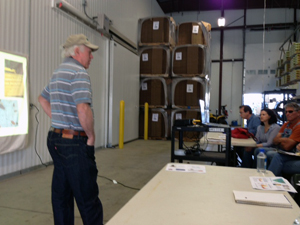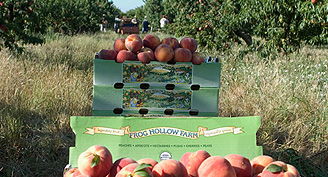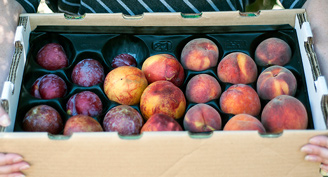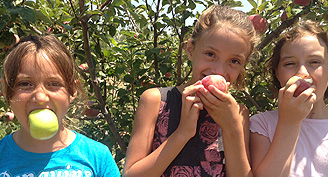 Last week we were treated to a lecture by Greg Young, our agronomist, and Christophe Kreis, our compost specialist, on approaches to stewarding soil health and disease resistance in the Orchard. There was a lot to absorb. My chemistry is pretty rusty, so all the details about Cation Exchange Capacity went a little over my head. But one thing is for sure. This refresher on conventional vs. organic approaches to production was a vivid reminder to us all of how important organic agriculture is to sustaining our planet and to creating a cropping system that grows healthy plants that are full of flavor.
The complexity of the interactions between soil and plant health is dizzying, and even magical. I couldn’t begin to convey a fraction of what we went over in the two-hour lecture, but here are a few take aways from the talk.
Conventional agriculture is very focused on growing crops that are large, nice looking, and have high yield. The primary tool for high yield and large crops is to apply synthetic nitrogen to the soil. Greg likens nitrogen to steroids in humans. Nitrogen will produce high yields and big crops but after time, the crop is unhealthy and very susceptible to disease and pest pressure. A crop needs a healthy balanced diet, just as we do. When a crop is harvested, it has used nitrogen, potassium, calcium, phosphorous, and much more to grow. Often times, only the nitrogen is replaced, or the other minerals are not sufficiently replaced, leaving the soil degraded of the diversity of nutrients a plant needs to be healthy and flavorful. Pesticides and fungicides are used to keep the plants healthy for harvest. And flavor, well, that suffers too. In our recent article on Brix, we learned about how inherently tied flavor is to soil health. The diversity of nutrients that are present in healthy soil and available to plants equate to higher sugar and micronutrient levels in crops.
Rates of nitrogen application have increased dramatically. World consumption of nitrogen in 1961was about 10,000 tons. In 2007 it was about 110,000 tons. According to a new study released last week by the EPA, more than half of the country’s rivers and streams are in poor biological health with the most common problem being high levels of nutrient pollution from nitrogen and phosphorous running into rivers and streams, with agricultural run-off being one of the major players in the pollution.
As CSA members you’ve already hear about our compost production. We LOVE compost more and more everyday and you will likely continue to hear us sing its praises. Compost is not an inert compound we apply to the soil. It’s alive! When it is applied to the soil, it inoculates it with billions of microbes that release nutrients to the soil when they excrete or decompose. This means the nutrients are released slowly and can be taken up by crops when they need it. Most amazingly, the plant root system actually sends out signals that attract the nutrients it needs. These beneficial microbes are also disease antagonists that will work to outcompete any pathogenic viruses and funguses that may be present in the soil.
When you compare how elegantly a well managed composting system feeds the soil and the plants growing in it to the norm of over application of synthetic nitrogen which leaches into our water, destroys microbial life in the soil, and leaves crops more susceptible to disease, you really have to wonder why so much our food is still grown this way. As always we thank you, our members, for making the choice to support us and other organic farms like us. We are the change we want to see.
Last week we were treated to a lecture by Greg Young, our agronomist, and Christophe Kreis, our compost specialist, on approaches to stewarding soil health and disease resistance in the Orchard. There was a lot to absorb. My chemistry is pretty rusty, so all the details about Cation Exchange Capacity went a little over my head. But one thing is for sure. This refresher on conventional vs. organic approaches to production was a vivid reminder to us all of how important organic agriculture is to sustaining our planet and to creating a cropping system that grows healthy plants that are full of flavor.
The complexity of the interactions between soil and plant health is dizzying, and even magical. I couldn’t begin to convey a fraction of what we went over in the two-hour lecture, but here are a few take aways from the talk.
Conventional agriculture is very focused on growing crops that are large, nice looking, and have high yield. The primary tool for high yield and large crops is to apply synthetic nitrogen to the soil. Greg likens nitrogen to steroids in humans. Nitrogen will produce high yields and big crops but after time, the crop is unhealthy and very susceptible to disease and pest pressure. A crop needs a healthy balanced diet, just as we do. When a crop is harvested, it has used nitrogen, potassium, calcium, phosphorous, and much more to grow. Often times, only the nitrogen is replaced, or the other minerals are not sufficiently replaced, leaving the soil degraded of the diversity of nutrients a plant needs to be healthy and flavorful. Pesticides and fungicides are used to keep the plants healthy for harvest. And flavor, well, that suffers too. In our recent article on Brix, we learned about how inherently tied flavor is to soil health. The diversity of nutrients that are present in healthy soil and available to plants equate to higher sugar and micronutrient levels in crops.
Rates of nitrogen application have increased dramatically. World consumption of nitrogen in 1961was about 10,000 tons. In 2007 it was about 110,000 tons. According to a new study released last week by the EPA, more than half of the country’s rivers and streams are in poor biological health with the most common problem being high levels of nutrient pollution from nitrogen and phosphorous running into rivers and streams, with agricultural run-off being one of the major players in the pollution.
As CSA members you’ve already hear about our compost production. We LOVE compost more and more everyday and you will likely continue to hear us sing its praises. Compost is not an inert compound we apply to the soil. It’s alive! When it is applied to the soil, it inoculates it with billions of microbes that release nutrients to the soil when they excrete or decompose. This means the nutrients are released slowly and can be taken up by crops when they need it. Most amazingly, the plant root system actually sends out signals that attract the nutrients it needs. These beneficial microbes are also disease antagonists that will work to outcompete any pathogenic viruses and funguses that may be present in the soil.
When you compare how elegantly a well managed composting system feeds the soil and the plants growing in it to the norm of over application of synthetic nitrogen which leaches into our water, destroys microbial life in the soil, and leaves crops more susceptible to disease, you really have to wonder why so much our food is still grown this way. As always we thank you, our members, for making the choice to support us and other organic farms like us. We are the change we want to see.

 Last week we were treated to a lecture by Greg Young, our agronomist, and Christophe Kreis, our compost specialist, on approaches to stewarding soil health and disease resistance in the Orchard. There was a lot to absorb. My chemistry is pretty rusty, so all the details about Cation Exchange Capacity went a little over my head. But one thing is for sure. This refresher on conventional vs. organic approaches to production was a vivid reminder to us all of how important organic agriculture is to sustaining our planet and to creating a cropping system that grows healthy plants that are full of flavor.
The complexity of the interactions between soil and plant health is dizzying, and even magical. I couldn’t begin to convey a fraction of what we went over in the two-hour lecture, but here are a few take aways from the talk.
Conventional agriculture is very focused on growing crops that are large, nice looking, and have high yield. The primary tool for high yield and large crops is to apply synthetic nitrogen to the soil. Greg likens nitrogen to steroids in humans. Nitrogen will produce high yields and big crops but after time, the crop is unhealthy and very susceptible to disease and pest pressure. A crop needs a healthy balanced diet, just as we do. When a crop is harvested, it has used nitrogen, potassium, calcium, phosphorous, and much more to grow. Often times, only the nitrogen is replaced, or the other minerals are not sufficiently replaced, leaving the soil degraded of the diversity of nutrients a plant needs to be healthy and flavorful. Pesticides and fungicides are used to keep the plants healthy for harvest. And flavor, well, that suffers too. In our recent article on Brix, we learned about how inherently tied flavor is to soil health. The diversity of nutrients that are present in healthy soil and available to plants equate to higher sugar and micronutrient levels in crops.
Rates of nitrogen application have increased dramatically. World consumption of nitrogen in 1961was about 10,000 tons. In 2007 it was about 110,000 tons. According to a new study released last week by the EPA, more than half of the country’s rivers and streams are in poor biological health with the most common problem being high levels of nutrient pollution from nitrogen and phosphorous running into rivers and streams, with agricultural run-off being one of the major players in the pollution.
As CSA members you’ve already hear about our compost production. We LOVE compost more and more everyday and you will likely continue to hear us sing its praises. Compost is not an inert compound we apply to the soil. It’s alive! When it is applied to the soil, it inoculates it with billions of microbes that release nutrients to the soil when they excrete or decompose. This means the nutrients are released slowly and can be taken up by crops when they need it. Most amazingly, the plant root system actually sends out signals that attract the nutrients it needs. These beneficial microbes are also disease antagonists that will work to outcompete any pathogenic viruses and funguses that may be present in the soil.
When you compare how elegantly a well managed composting system feeds the soil and the plants growing in it to the norm of over application of synthetic nitrogen which leaches into our water, destroys microbial life in the soil, and leaves crops more susceptible to disease, you really have to wonder why so much our food is still grown this way. As always we thank you, our members, for making the choice to support us and other organic farms like us. We are the change we want to see.
Last week we were treated to a lecture by Greg Young, our agronomist, and Christophe Kreis, our compost specialist, on approaches to stewarding soil health and disease resistance in the Orchard. There was a lot to absorb. My chemistry is pretty rusty, so all the details about Cation Exchange Capacity went a little over my head. But one thing is for sure. This refresher on conventional vs. organic approaches to production was a vivid reminder to us all of how important organic agriculture is to sustaining our planet and to creating a cropping system that grows healthy plants that are full of flavor.
The complexity of the interactions between soil and plant health is dizzying, and even magical. I couldn’t begin to convey a fraction of what we went over in the two-hour lecture, but here are a few take aways from the talk.
Conventional agriculture is very focused on growing crops that are large, nice looking, and have high yield. The primary tool for high yield and large crops is to apply synthetic nitrogen to the soil. Greg likens nitrogen to steroids in humans. Nitrogen will produce high yields and big crops but after time, the crop is unhealthy and very susceptible to disease and pest pressure. A crop needs a healthy balanced diet, just as we do. When a crop is harvested, it has used nitrogen, potassium, calcium, phosphorous, and much more to grow. Often times, only the nitrogen is replaced, or the other minerals are not sufficiently replaced, leaving the soil degraded of the diversity of nutrients a plant needs to be healthy and flavorful. Pesticides and fungicides are used to keep the plants healthy for harvest. And flavor, well, that suffers too. In our recent article on Brix, we learned about how inherently tied flavor is to soil health. The diversity of nutrients that are present in healthy soil and available to plants equate to higher sugar and micronutrient levels in crops.
Rates of nitrogen application have increased dramatically. World consumption of nitrogen in 1961was about 10,000 tons. In 2007 it was about 110,000 tons. According to a new study released last week by the EPA, more than half of the country’s rivers and streams are in poor biological health with the most common problem being high levels of nutrient pollution from nitrogen and phosphorous running into rivers and streams, with agricultural run-off being one of the major players in the pollution.
As CSA members you’ve already hear about our compost production. We LOVE compost more and more everyday and you will likely continue to hear us sing its praises. Compost is not an inert compound we apply to the soil. It’s alive! When it is applied to the soil, it inoculates it with billions of microbes that release nutrients to the soil when they excrete or decompose. This means the nutrients are released slowly and can be taken up by crops when they need it. Most amazingly, the plant root system actually sends out signals that attract the nutrients it needs. These beneficial microbes are also disease antagonists that will work to outcompete any pathogenic viruses and funguses that may be present in the soil.
When you compare how elegantly a well managed composting system feeds the soil and the plants growing in it to the norm of over application of synthetic nitrogen which leaches into our water, destroys microbial life in the soil, and leaves crops more susceptible to disease, you really have to wonder why so much our food is still grown this way. As always we thank you, our members, for making the choice to support us and other organic farms like us. We are the change we want to see.






